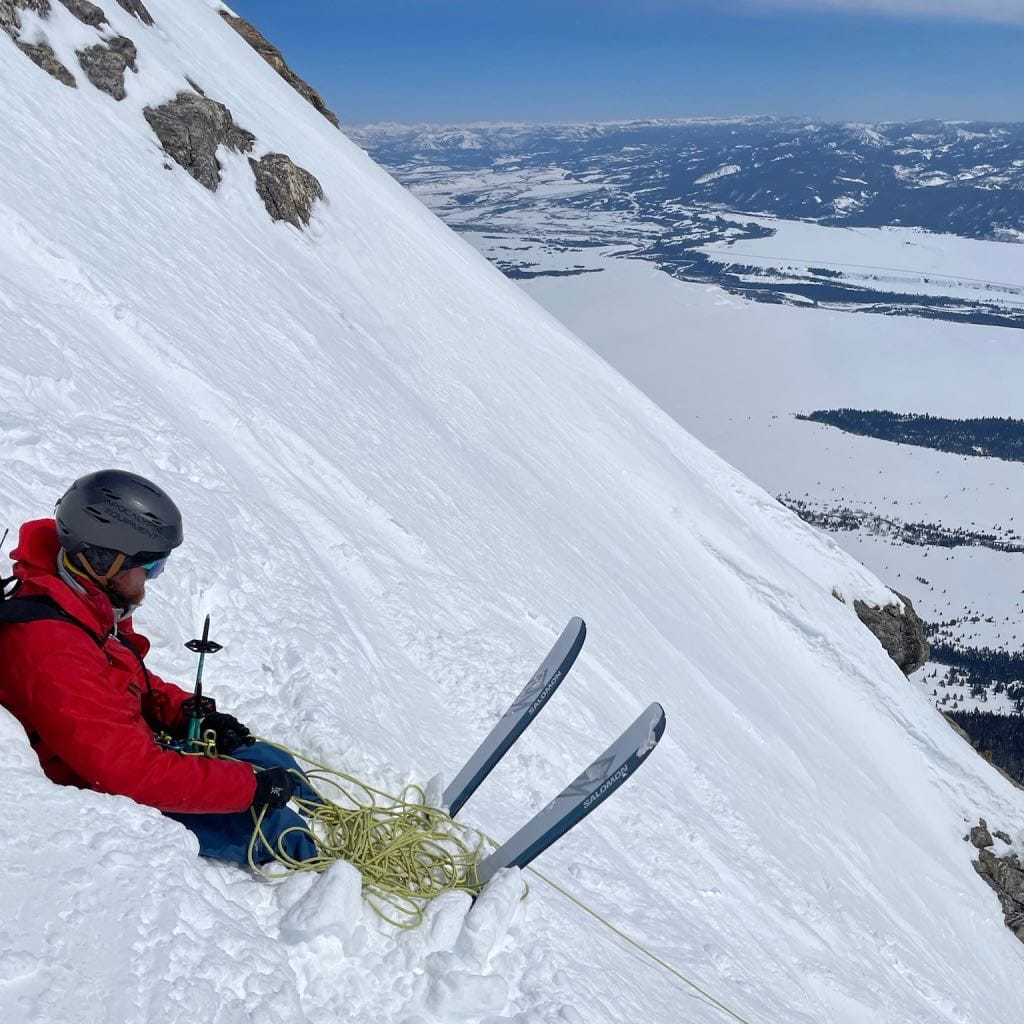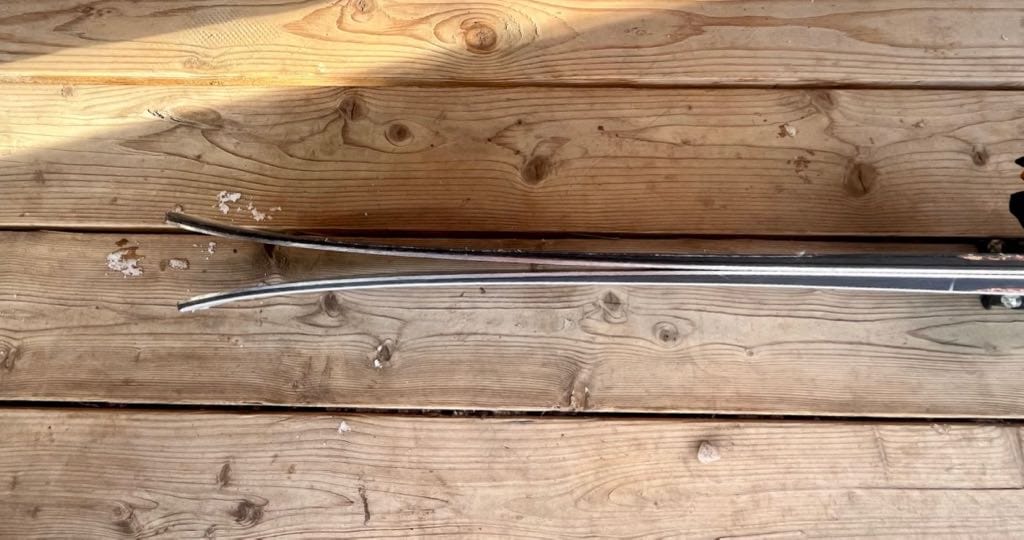Salomon QST Echo
As part of the behemoth Amer Sports Group, Salomon, Atomic, and Armada seem to have an interesting relationship—sharing designs and ideas at times while seeming to compete at others. A few years ago, I remember reading a theory that Amer was positioning Salomon as the freeride/piste-oriented brand while Atomic would continue to lean into the touring market. Despite these ideas, Salomon continues to update and release compelling touring options, like the updated MTN skis and boots released over the last few seasons. Something tells me a prominent Salomon athlete getting deeper and deeper in the touring world has some influence on the direction of the Salomon touring line.
The MTN series of skis has had a strong following as a spring/mountaineering ski with skiers that spend most of their time on heavier or resort models. Likely, this is related to their (especially the previous generation) heavier weight and medium flex that made them feel more damp and stable compared to other prevalent options boasting lighter or stiffer builds. What Salomon has lacked, in modern times, is a wider and more soft snow oriented touring ski for the masses. While they have always had plenty of touring-focused athletes, they often skied the resort-oriented QST line, which mostly comes in at or around 2000g. Probably not skis the rest of us would choose to buy for touring. In many ways, it was about time for Salomon to release the touring-specific QST Echo.
Design Highlights
In the most basic terms, the QST Echo is a QST 106, minus about 220g (in a 181cm). Perhaps this doesn’t give Salomon enough credit for the design work that goes into shaving weight without ruining performance metrics that the original shape was designed around, or perhaps it feeds right into Salomon’s marketing claims that the Echo maintains the performance of the QST while shaving 200g.
Stepping back to the shared shape and profile of the Echo and QST 106, it is a quintessential, if somewhat generic, “mid-fat freeride ski.” I can almost imagine if you gave some AI program that exact prompt, the QST 106 is what it would come up with. To be clear, this isn’t a slight to the QST 106, but rather to say that it is a solid, agreeable, and generalist ski shape. Starting at the tip, you have a wide, tapered shovel with 38 cm of tip rocker length and a modest 57mm tip height. In the midsection, a few mm of camber pairs with a 19m turn radius, then a tapered and rockered tail (25cm long, 35mm tail height). The topsheet graphic is decidedly less cool than the QST 106, but I’ll give credit where it’s due; it’s nice to see a white top sheet on a touring ski. Combined with the colorful base, perhaps it strikes a balance between minimizing snow buildup and being findable in case of a crash in powder.

Full profile, quite a bit of tip and tail rocker combines with a few mm of camber underfoot. The profile didn’t change enough closing the camber to feel worth a second set of photos.
The flex pattern of the Echo is unique, although characteristic of many Salomon skis. The tip and tail are very soft, with the stiffness ramping up a bit underfoot. Overall, they are slightly stiffer torsionally, but I would describe the flex as notably soft throughout. Soft does not equate to a noodly construction in this case. The Echo has a full wrap sidewall and a second sidewall where the ski is thicker underfoot. They use a Karuba/Poplar core with basalt reinforcement and a titanal binding area reinforcement. The tips and tails have a cork insert, aka Cork Damplifier, to lighten the swing weight while “damplifying”…? I had no durability issues with the Echo, aside from some minor chipping and peeling on the clear topsheet cover. The bases and edges seem quite robust, and the full sidewall is confidence inspiring.

The double, recycled sidewall underfoot. The colorful second sidewall corresponds well with the stiffer underfoot section of the ski.
Salomon has two recommended mount lines on the ski, one labeled MTN at -8cm from center and an Alpine + Shift line at -9cm. I’m still trying to wrap my head around this recommendation—given the ramp (~+9mm) of the MTN binding (vs. alpine bindings mostly being flatter), one might mount a tech binding further back to compensate for the further forward weight distribution. Perhaps the thought is to make the ski easier to maneuver/engage with lighter boots and bindings by using a forward mount. I’m not sure of the intention here, but +/- 1cm is a pretty subtle change on most skis, so maybe we should just stick to the broader narrative here—the Echo has a relatively directional mount point.
I often enjoy the brain exercise of testing a ski with significant design input from a pro and then relating back to that skier’s style. The 4FRNT Hoji is a perfect example of this; watch Hoji rip down the fall line before slashing and pivoting his way through a pillow line, then ski a pair of Hojis, and it’s quickly apparent that he designed the ski for exactly the type of skiing he is doing. When I think of Mr. Townsend’s skiing, I picture some quickness edge to edge with low hips and finishing turns across the fall line—a bit of “I spent my childhood bashing gates” flair. More on this later, but I felt the QST Echo fit my idea of how they were meant to be skied.
Testing Setup
I received the QST Echo last February, in the 181 cm length, mounted with the new MTN Summit binding. I mostly used my Zero G Peak boots, with a few days in the Zero G Tour Pro. They included Salomon branded skins, which worked well, although the Hybrid glue continues to be unreliable on cold, multi-lap days. I would guess that most skiers would be happier in a 2+ buckle or beefier touring boot with the Echo, although with a nuanced pilot, 1kg boots drove the ski just fine in most conditions.
Field Testing the QST Echo 106
Powder/soft snow
The Echo excelled in shallow to boot top powder. A resounding theme throughout my testing was its quickness and maneuverability—this made for faster powder skiing, whether from settlement or just smaller storms, an absolute hoot. I would characterize the quickness as a very different feel from reverse cambered skis like the Hoji—the Echo wasn’t as ready to slash and pivot on a dime, but it felt agile moving edge to edge and could flex and carve to make a turn happen quickly.
In deep powder, they floated well for their size, as expected, given the amount of rocker. They weren’t a top choice for the deep days; aside from the obvious choice of a wider ski, they tended to bog down a bit and lose the liveliness and quickness that made them so fun in shallower powder. It’s not so much that they didn’t float, just that deeper powder didn’t allow their best characteristics to shine.

The base graphic is a bit more exciting than the top sheet. Likely also helpful in the event of a deep snow ski ejection.
Crud/tracked/variable snow
This type of snow was the performance highlight for the Echo. The combination of softer flex throughout and lots of taper made for, perhaps, the best variable snow performance I have experienced in a cambered touring ski. Some standout performances include a bell-to-bell sunny powder day in Grand Teton National Park, where ENE-E slopes developed a zipper crust throughout the day over otherwise fast, settled powder. In the group were some reverse camber 4FRNTs, I was on the Echo, and a few pairs of Black Crows Navis Freebirds. On the Echo, as well as the 4FRNTs, we could ski with the same speed and joy all day—even as the solar crusts developed and refroze. The Echo’s tapered tip sliced through the crust like a hot knife through butter.
Perhaps more unique to the Echo is the suspension and dampness provided by a light-ish touring ski. Indeed, the bit of added heft relative to 1500g-ish skis helps, but the soft flex seems to play an even bigger role. The Echo is likely the softest flexing ski I have used, and despite my initial concerns with that aspect, the flex profile is tuned such that it works really well in many of the snow conditions that most lightweight touring skis struggle with. This excellent performance applied to tracked-out powder, old soft slab debris, wind board and breakable crusts, and pretty much everything in between.
Firm Snow/Steeps
After some great experiences in poor snow, I was psyched to bring the Echo into some steeper and more technical skiing. My go-to joke with the Echo in a tight spot was that it was so soft I could have my tips and tails on rock, but they flexed enough to get some edge on the snow underfoot.
While these wouldn’t be my first choice for firm steeps where I know I’ll be making jump turns, there were a bunch of situations last winter where I brought them out for days in the high peaks or some funky technical skiing in generally soft conditions. Between their weight, somewhat short turning radius/effective edge (due to all the taper), and general softness, they only check a few of my steep skiing boxes. That being said, the Echo performed admirably when I gave it a chance. Like the ZAG Adret 85, which was somewhat soft but felt “grippy and well adhered” in firm snow, the Echo felt quite confident and grippy in firmer, steeper snow. Making jump turns, you definitely feel the extra weight on your feet—they don’t feel flickable and snappy like a lighter or ski with less swing weight.
I was surprised to feel that the tail felt more confident and locked in than I had expected, given its rocker profile. It can’t compare with a flatter-tailed ski like the Blizzard Zero G 105 or Black Crows Navis. However, relative to something like the Nordica Enforcer 104 UL, the tail felt more confidence inspiring and less “slarvy” than I expected.
Resort Skiing/groomers
The QST is heavier than most would want for a resort uphill ski, so the likely scenario is more like a 50/50 setup or occasional resort use. I was fortunate to spend two days skiing with my family at Jackson Hole Mountain Resort on the Echo last March. I had a great time on soft groomers, bumps, tree skiing, etc. Many of the attributes discussed above played well inbounds; the quickness edge to edge, decent edge grip, and good suspension all added to an enjoyable experience. I would say this speaks well to the overall versatility of the Echo—I haven’t found terrain or conditions that it hasn’t handled well.
The medium turning radius and soft flex made the Echo feel pretty easygoing while carving on groomers. It was fun to rail turns on soft, low angle terrain at JHMR. I was far more nervous about pushing too hard and coming out of my tech bindings (or crashing and not coming out) than I was about any speed limit, high-speed flapping, or twitchiness from the Echo. Perspective likely matters here—I don’t spend time on skis over 2000g (almost ever), so perhaps I can better appreciate good suspension within the weight classes that I am more familiar with. While many of us at The High Route would agree that 50/50 bindings are a poor option for lots of touring, I could see this being a good option for that 50/50 ski for someone newer to the sport and looking to mostly ski inbounds without having full-blown boat anchors for their first forays into touring.
Conclusion
Thinking back on using the QST Echo makes me appreciate how much I enjoyed the ski. Some combination of the topsheet graphic, which looks better suited to a low-budget rental fleet, and the heavy, brake-laden bindings (I generally ski on race bindings), had clouded my memory a bit over the summer. Looking back on my notes and compiling my experiences, I am really impressed with the Echo’s versatility. The saying goes, jack of all trades, master of none. This sentiment may not give the Echo the credit it deserves either, as it may be the sub-1800 g master of bad snow.

A bit of damage on the tails. It took me a bit to figure out what is “off” here, then I realized, the topsheet is laid up over top of the abs tail protector, which likely explains the bit of damage here.
There is part of me that wishes Salomon could have reduced the weight of the Echo to around 1600g in the 181cm weight. Still, I think a large contingency of skiers out there will be okay with taking a bit of a weight penalty to keep the suspension and dampness that is often lost when going from resort ski to touring ski. Paired with a sub 200g binding and some Pomoca Free Pro 2.0’s, I reckon many of us weight-conscious ski tourists would be satiated with the ski’s weight and pretty blown away when the going gets tough on the way down.
Specs
Available lengths (cm): 157, 165, 173, 181(tested), 189
Weight: claimed – 1760g (Measured at )[181]
Side cut: 139-106-126 [181]
Turn radius: 19m [181]
Core: Karuba/Poplar core with basalt fiber laminate, cork “damplifier” in shovels.
Build Comments: Double sidewall (extra sidewall underfoot) with recycled content, tip edge, 30% recycled topsheet, titanal binding plate.
Shape: Tip and Tail Rocker, Camber underfoot, tapered tip.
Testing Setup: Salomon MTN Summit Bindings, Technica Zero G Peak and Zero G Tour Pro.
Similar Models: Faction La Machine Mega, Blizzard Hustle 10, Nordica Enforcer 104 Unlimited.
Price: $799.95







